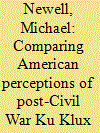| Srl | Item |
| 1 |
ID:
174713


|
|
|
|
|
| Summary/Abstract |
Recently, public debates have questioned whether or not the American government responds differently to terrorism by white, right-wing, Americans. This article examines a historical period in which similar dynamics were on display in state responses to the Reconstruction-era Ku Klux Klan (KKK), Irish-American Fenians, and anarchists from 1860 to 1920. This history suggests that political officials responded to these groups more on the basis of ideas than their actual levels of violence, including discourses of Americanism shaped by ideology, nativism, and racism. Successful claims to ‘Americanism’ lent the KKK a sense of familiarity that led it to be seen as less of a threat to ontological security, even as it posed a significant threat of physical violence. In contrast, the ideologically subversive and foreign anarchists were responded to more severely, despite being responsible for far fewer deaths and injuries than the KKK. This history suggests that American counter-terrorism has been influenced by factors of racial and national belonging in the past, and provides significant context for the consideration of current debates about responses to right-wing groups.
|
|
|
|
|
|
|
|
|
|
|
|
|
|
|
|
| 2 |
ID:
110913


|
|
|
|
|
| Publication |
2012.
|
| Summary/Abstract |
In recent years, the field of security studies has turned increasing attention to the processes through which security threats are constructed. Two approaches in particular have flourished, securitisation and framing, but scholars working within these frameworks generally do not draw on the other body of literature to inform theoretical development or to accumulate cases. This has resulted in the production of parallel literatures and the duplication of concepts and terminology, and has hindered the development of theory. This article demonstrates that securitisation and framing are substantively similar research programmes, that security operates as one of a number of distinct master frames, and that securitisation should be viewed as a subfield of framing. This would produce a division of labour whereby securitisation scholars could continue to focus on the distinct realm of security, while drawing on the broader framing literature to inform a number of areas that are under-theorised in present securitisation studies, such as audience acceptance, non-linguistic communicative forms, empowerment and marginalisation, and resistance and desecuritisation.
|
|
|
|
|
|
|
|
|
|
|
|
|
|
|
|